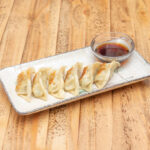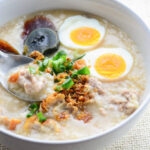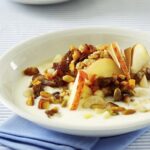Dragon fruit tart is a delicious and visually stunning dessert that combines the vibrant colors and unique flavors of dragon fruit with a buttery tart crust. This dessert is perfect for those looking to indulge in a sweet treat that is both refreshing and satisfying. The tartness of the dragon fruit pairs perfectly with the sweetness of the filling, creating a harmonious balance of flavors. Whether enjoyed on its own or topped with whipped cream or fresh fruits, dragon fruit tart is sure to impress both your taste buds and your guests.
| Ingredients | |
| 1 | 1 ½ cups all-purpose flour |
| 2 | ½ cup unsalted butter, cold and cubed |
| 3 | ¼ cup powdered sugar |
| 4 | 1 egg yolk |
| 5 | 2 tablespoons ice water |
| 6 | 2 cups dragon fruit, peeled and diced |
| 7 | ½ cup granulated sugar |
| 8 | 2 tablespoons cornstarch |
| 9 | 1 tablespoon lemon juice |
| 10 | Whipped cream or fresh fruits for topping (optional) |
Step-by-step cooking instruction of Dragon Fruit Tart:
Step-1 In a food processor combines the flour, powdered sugar, and cold butter. Pulse until coarse crumbs form from the mixture.
Step-2 Add the egg yolk and ice water to the food processor and pulse until the dough comes together. One tablespoon at a time, add more cold water as necessary.
Step-3 Transfer the dough onto a lightly floured surface and knead it gently until it forms a smooth ball. Refrigerate it for a minimum of half an hour after wrapping it in plastic wrap.
Step-4 Preheat your oven to 375°F (190°C).
Step-5 Roll out the chilled dough onto a floured surface to fit your tart pan. Press the dough into the pan, making sure to evenly distribute it along the bottom and sides.
Step-6 In a bowl, mix together the diced dragon fruit, granulated sugar, cornstarch, and lemon juice until well combined.
Step-7 Pour the dragon fruit mixture onto the prepared tart crust and spread it out evenly.
Step-8 Bake the tart in the preheated oven for about 25-30 minutes or until the crust is golden brown and the filling is bubbly.
Step-9 Remove from the oven and let it cool completely before serving.
Step-10 Optional: Top with whipped cream or fresh fruits before serving for added flavor and decoration.
Nutritional values Dragon Fruit Tart:
The nutritional values of a dragon fruit tart can vary depending on the specific recipe and ingredients used. However, here is a general breakdown of the key nutrients found in a typical dragon fruit tart:
| 1 | Calories: A slice of dragon fruit tart can range from around 200 to 300 calories, depending on the size and ingredients used. |
| 2 | Carbohydrates: Dragon fruit tarts are typically high in carbohydrates due to the crust and sugar content. The exact amount can vary, but it is usually around 30-40 grams per serving. |
| 3 | Fat: The butter used in the crust contributes to the fat content of the tart. It can range from 10 to 20 grams per serving. |
| 4 | Protein: Dragon fruit tarts are not a significant source of protein. They generally contain around 2-4 grams per serving. |
| 5 | Fiber: The dragon fruit itself contains dietary fiber, which can contribute to the overall fiber content of the tart. It is usually around 2-4 grams per serving. |
| 6 | Vitamins and Minerals: Dragon fruit is rich in vitamin C, antioxidants, and various minerals such as iron and calcium. These nutrients may be present in smaller amounts in a dragon fruit tart, depending on the recipe and ingredients used. |
Background History of Dragon Fruit Tart:
The exact origin and history of dragon fruit tart is difficult to trace, as it is a modern dessert that combines the popular tropical fruit, dragon fruit, with a classic tart crust. However, we can explore the background of both dragon fruit and tarts to understand how this delicious dessert came to be.
Dragon fruit, also known as pitaya, is native to Central America but is now grown in various tropical regions around the world. It has a vibrant pink or yellow skin with green scales and a unique white or red flesh speckled with tiny black seeds. Dragon fruit is known for its sweet and mildly tangy flavor, making it a popular ingredient in desserts.
Tarts, on the other hand, have a long history dating back centuries. The word “tart” originated from the Latin word “tortus,” meaning twisted or rolled. Tarts were initially made with a simple pastry crust filled with fruits or savory ingredients. Over time, tarts evolved into various forms and flavors, becoming a staple in many cuisines worldwide.
The combination of dragon fruit and tart likely emerged as a creative way to showcase the vibrant colors and unique flavors of the fruit in a dessert form. By incorporating dragon fruit into a tart crust and filling, it adds an exotic twist to the traditional tart recipe .
Today, dragon fruit tarts are enjoyed by people around the world as a visually appealing and delicious dessert option. They are often served at special occasions or enjoyed as a refreshing treat during hot summer months.
While there may not be an extensive historical background specific to dragon fruit tarts, their popularity continues to grow as more people discover and appreciate the unique taste and appearance of this delightful dessert.
| Advantages of Dragon Fruit Tart | |
| 1 | Nutritional Benefits: Dragon fruit is rich in antioxidants, vitamin C, and fiber, which can provide various health benefits. By incorporating dragon fruit into a tart, you can enjoy these nutrients in a delicious dessert form. |
| 2 | Unique Flavor: Dragon fruit has a sweet and mildly tangy flavor that adds a unique taste to the tart. It can be a refreshing and exotic twist on traditional tart flavors. |
| 3 | Eye-Catching Appearance: The vibrant pink or yellow color of dragon fruit adds visual appeal to the tart. It can make for an impressive and Instagram-worthy dessert that stands out on any table. |
| 4 | Versatility: Dragon fruit tarts can be customized with different toppings or fillings to suit personal preferences. You can add whipped cream, fresh fruits, or even drizzle with chocolate for added flavor and decoration. |
| Disadvantages of Dragon Fruit Tart | |
| 1 | Availability: Dragon fruit may not be readily available in all regions or during certain seasons. This can make it challenging to find fresh dragon fruit for making the tart. |
| 2 | Cost: Dragon fruit can be relatively expensive compared to other fruits, especially if it needs to be imported or purchased out of season. This can increase the overall cost of making the tart. |
| 3 | Sugar Content: Tarts typically contain sugar in both the crust and filling. While dragon fruit itself is naturally sweet, additional sugar may be added to enhance the flavor. This can contribute to the overall sugar content of the dessert. |
| 4 | Preparation Time: Making a dragon fruit tart from scratch requires time and effort, including preparing the crust, slicing and preparing the dragon fruit, and baking the tart. It may not be suitable for those looking for quick and easy dessert options. |
Compare with Similar meal Dragon Fruit Tart:
Similar desserts or meals that incorporate dragon fruit or have similar flavor profiles to a dragon fruit tart include:
| 1 | Dragon Fruit Smoothie Bowl: Blend dragon fruit with other fruits, such as bananas and berries, along with some liquid (such as coconut water or almond milk) to create a thick and creamy smoothie bowl. For extra texture, sprinkle nuts, granola, and sliced fruits on top. |
| 2 | Dragon Fruit Parfait: Layer diced dragon fruit with yogurt, granola, and honey in a glass or jar to create a visually appealing and nutritious dessert or breakfast option. |
| 3 | Dragon Fruit Sorbet: Puree dragon fruit with sugar syrup and lemon juice, then freeze the mixture to make a refreshing sorbet. Serve it on its own or as a topping for other desserts. |
| 4 | Dragon Fruit Salad: Combine diced dragon fruit with other tropical fruits like mangoes, pineapples, and kiwis for a colorful and refreshing salad. For added taste, you can also add a drizzle of honey or a squeeze of lime juice. |
| 5 | Dragon Fruit Popsicles: Blend dragon fruit with coconut milk or yogurt, sweeten it with honey or agave syrup if desired, then pour the mixture into popsicle molds and freeze until solid. These homemade popsicles are perfect for hot summer days. |
| 6 | Dragon Fruit Cheesecake: Incorporate dragon fruit puree into a classic cheesecake recipe to add a vibrant color and unique flavor twist to the dessert. |
Mostly questions asked about Dragon Fruit Tart
1: How do I make a dragon fruit tart?
A: To make a dragon fruit tart, start by preparing a tart crust using flour, butter, sugar, and salt. In a tart pan, press the dough firmly, and bake until golden brown. For the filling, blend dragon fruit with sugar, lemon juice, and cornstarch until smooth. Cook the mixture on the stovetop until thickened, and then pour it into the baked tart crust. Chill in the refrigerator until set, and serve with whipped cream or fresh fruits.
2: Where can I buy dragon fruit for my tart?
A: Dragon fruit can be found at many grocery stores, especially those that carry a variety of tropical fruits. You can also check local farmers’ markets or specialty stores that focus on exotic produce. If fresh dragon fruit is not available in your area, you may be able to find frozen dragon fruit pulp or puree online or in specialty stores.
3: Can I use frozen dragon fruit for my tart?
A: Yes, you can use frozen dragon fruit for your tart. Thaw the frozen dragon fruit before blending it for the filling. Keep in mind that frozen dragon fruit may have a slightly different texture compared to fresh dragon fruit.
4: Can I substitute dragon fruit with another fruit in the tart?
A: Yes, you can substitute dragon fruit with other fruits in your tart if desired. Some fruits that work well in tarts include berries (such as strawberries or raspberries), peaches, mangoes, or even apples. Adjust the sweetness and flavors accordingly based on the chosen fruit.
5: How long does a dragon fruit tart last?
A: A properly stored dragon fruit tart can last for 2-3 days when refrigerated. Cover it tightly with plastic wrap or store it in an airtight container to maintain freshness.
6: Can I freeze a dragon fruit tart?
A: While it is possible to freeze a dragon fruit tart, the texture of both the crust and filling may be affected. The tart may become slightly soggy upon thawing. If you do freeze it, wrap it tightly in plastic wrap and place it in an airtight container. In the fridge, let it thaw before serving.
7: Can I make a vegan or gluten-free dragon fruit tart?
A: Yes, you can adapt a dragon fruit tart recipe to be vegan or gluten-free. For a vegan version, use plant-based butter or coconut oil for the crust and substitute dairy products with non-dairy alternatives in the filling. For a gluten-free version, use a gluten-free flour blend or almond flour for the crust.
8: How can I enhance the flavor of my dragon fruit tart?
A: To enhance the flavor of your dragon fruit tart, you can add additional ingredients such as lemon zest, vanilla extract, or a sprinkle of cinnamon to the crust or filling. You can also top the tart with fresh mint leaves or a drizzle of honey for added aroma and sweetness.
9: Can I make mini dragon fruit tarts instead of one large tart?
A: Yes, you can make mini dragon fruit tarts by using individual tart pans or muffin tins. Adjust the baking time accordingly since smaller tarts will require less time to cook.
10: Can I use canned dragon fruit for my tart?
A: While fresh dragon fruit is preferred for its vibrant color and flavor, you can use canned dragon fruit if fresh is not available. Drain the canned dragon fruit well before blending it for the filling to remove excess liquid. Keep in mind that canned dragon fruit may have a softer texture compared to fresh dragon fruit.







